Haben Sie schon einmal versucht, einen Ihrer WordPress-Beiträge zu öffnen, nur um von einem 404-Fehler begrüßt zu werden? Manchmal erleben wir das, wenn wir an unseren eigenen WordPress-Seiten arbeiten oder unseren Benutzern helfen
Dieser Fehler tritt auf, wenn Sie auf Ihren WordPress-Administrationsbereich und Ihr Blog zugreifen können, aber wenn Sie versuchen, einen bestimmten Beitrag zu öffnen, erhalten Sie die Meldung „404 Not Found“.
Es kann frustrierend sein, wenn Ihre Inhalte scheinbar verschwinden, aber wir haben einige Lösungen gefunden, um dieses Problem zu beheben. In dieser vollständigen Anleitung zeigen wir Ihnen, wie Sie WordPress-Beiträge mit 404-Fehlern beheben können.
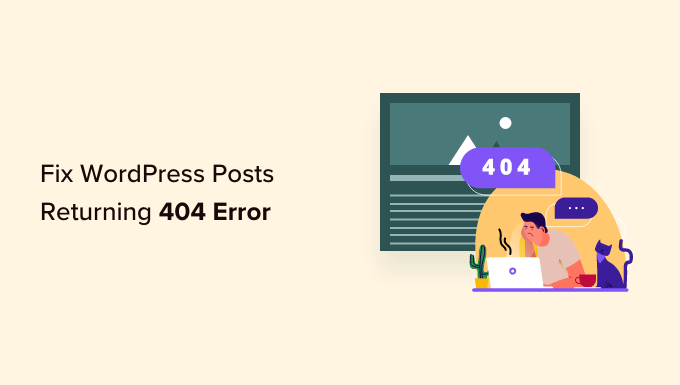
Warum erhalten meine WordPress-Beiträge einen 404-Fehler?
Es gibt mehrere Gründe, warum Ihre Beiträge in WordPress einen 404 „Seite nicht gefunden“-Fehler anzeigen. Diese können sein:
- Konflikte mit Plugins oder Themes: Manchmal können Plugins oder Themes, die Sie auf Ihrer Website installiert haben, die Handhabung von Permalinks durch WordPress beeinträchtigen. Dies kann zu fehlerhaften Links und 404-Fehlern führen.
- Probleme mit benutzerdefiniertem Code: Wenn Sie Ihrer Website benutzerdefinierten Code hinzugefügt haben, kann es sein, dass der Code Fehler enthält, die sich auf Permalinks auswirken oder andere Konflikte verursachen, was zu 404-Fehlern für Ihre Beiträge führt.
- Probleme mit Ihrer .htaccess-Datei: Die .htaccess-Datei spielt eine Rolle dabei, wie WordPress URLs strukturiert. Wenn diese Datei beschädigt ist oder fehlt, kann dies zu 404-Fehlern für Ihre Beiträge oder Seiten führen.
Wie man alle WordPress-Beiträge mit 404-Fehlern findet
Bevor wir zu den Lösungen kommen, wäre es gut, herauszufinden, ob der Fehler nur bei einem oder zwei Beiträgen oder bei mehreren Beiträgen auftritt. Auf diese Weise können Sie den Umfang des Problems bestimmen und die am besten geeignete Lösung wählen.
Eine einfache Möglichkeit, dies herauszufinden, ist die Verwendung der Google Search Console. Wenn Sie Ihre Website noch nicht bei Google Search Console angemeldet haben, lesen Sie unseren Leitfaden zum Hinzufügen Ihrer WordPress-Website zu Google Search Console.
Sobald der Google-Bot Ihre Website gecrawlt und indexiert hat, liefert Ihnen die Google Search Console detaillierte Informationen über die Leistung Ihrer Website, einschließlich aller 404-Fehler, auf die sie stößt.
Um herauszufinden, bei welchen Beiträgen 404-Fehler auftreten, können Sie sich im Dashboard der Search Console anmelden. Navigieren Sie dann zum Bericht „Seiten“ und Sie sehen eine detaillierte Liste aller Fehler.
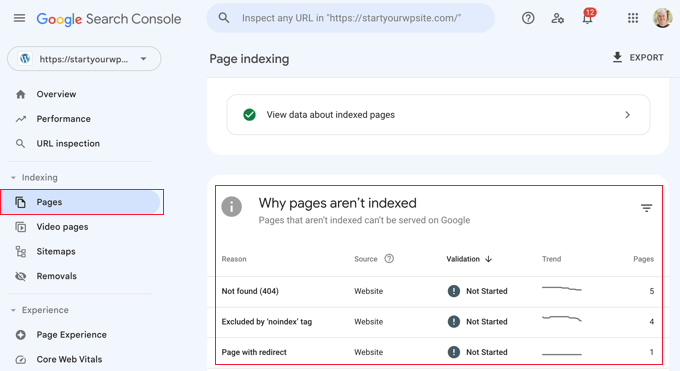
Weitere Informationen finden Sie in unserer Liste mit Tipps für die Verwendung der Google Search Console zur Steigerung des Website-Traffics, die auch einige Tipps zur Behebung von 404-Fehlern mit dem Tool enthält.
Sehen wir uns also an, wie man WordPress-Beiträge mit 404-Fehlern beheben kann. Sie können die Links unten verwenden, um direkt zu den verschiedenen Lösungen zu springen:
Keine Zeit, 404-Fehler selbst zu beheben? WPBeginner Pro Services kann helfen! Mit unserem erschwinglichen WordPress-Notfallsupport können Sie Experten beauftragen, 404-Fehler, defekte Links, Weiterleitungsprobleme und vieles mehr zu beheben. Hören Sie auf, sich über WordPress-Probleme zu ärgern und lassen Sie sie beheben! Vereinbaren Sie noch heute einen Notfall-Support für WordPress!
Methode 1: Suchen Sie nach Plugin- oder Theme-Konflikten und benutzerdefinierten Code-Problemen
Manchmal können Plugins, Themes oder benutzerdefinierter Code, den Sie zu Ihrer WordPress-Website hinzugefügt haben, Permalinks beeinträchtigen oder Konflikte verursachen, die zu 404-Fehlern führen. Wir haben das sogar schon selbst erlebt, als wir Tools auf unserer Demo-Website getestet haben.
Eine Möglichkeit, dieses Problem zu lösen, besteht darin, Plugins vorübergehend zu deaktivieren. Plugins können manchmal stören, wie WordPress mit Links umgeht.
Nachdem Sie die Plugins deaktiviert haben, können Sie sie nacheinander reaktivieren und dabei überprüfen, ob der 404-Fehler nach der Aktivierung der einzelnen Plugins erneut auftritt. Wenn der Fehler nach der Aktivierung eines bestimmten Plugins auftritt, könnte dieses der Übeltäter sein.
Sie können dann eine schnelle Google-Suche nach Lösungen für dieses Plugin durchführen oder den Plugin-Entwickler um Unterstützung bitten.
Auch Ihr WordPress-Theme könnte die Ursache für den Konflikt sein.
Um das zu überprüfen, können Sie vorübergehend zu einem Standard-WordPress-Theme wie Twenty Twenty-Three oder Twenty Twenty-Four wechseln. Dazu müssen Sie nur auf Darstellung „ Themes gehen und bei einem Standard-Theme auf „Aktivieren“ klicken.

Wenn der 404-Fehler mit dem Standard-Theme verschwindet, deutet dies auf einen möglichen Konflikt mit Ihrem aktuellen Theme hin. Sie können dann versuchen, das Problem mit dem Theme zu beheben oder ein anderes Theme zu verwenden.
In unserer Expertenauswahl der beliebtesten WordPress-Themes finden Sie Empfehlungen.
Wenn Sie kürzlich Codeschnipsel in Ihre Website eingefügt haben, kann es sein, dass der Code Fehler enthält, die die 404-Fehler verursachen. Schauen Sie sich den hinzugefügten Code genau an und prüfen Sie, ob Sie Fehler finden können.
Der sicherste Weg, Code-Schnipsel in WordPress einzufügen, ist das WPCode-Plugin. Mit diesem Plugin können Sie benutzerdefinierten Code einfügen, ohne direkt mit den Themadateien zu arbeiten, wodurch das Risiko, dass Ihre Website beschädigt wird, verringert wird.
Und wenn WPCode einen Fehler in Ihrem Code entdeckt, wird das Snippet automatisch deaktiviert und Sie werden aufgefordert, es zu überprüfen. Sie können auch den Testmodus verwenden, um zu prüfen, ob Ihr Code funktioniert, bevor Sie ihn auf Ihre Live-Website übertragen.
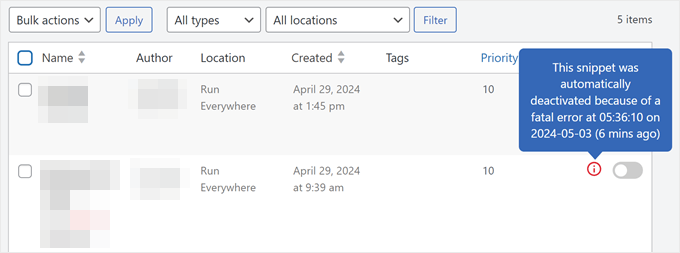
Wenn keine dieser Lösungen funktioniert, fahren Sie mit der nächsten Methode fort, bei der wir Ihre Permalink-Einstellungen überprüfen werden.
Methode 2: Reparieren Sie Ihre Permalink-Einstellungen
WordPress-Beiträge können aufgrund von Problemen mit Rewrite-Regeln in Ihrer .htaccess-Datei 404-Fehler zurückgeben. In den meisten Fällen können Sie das Problem beheben, indem Sie Ihre Permalink-Einstellungen aktualisieren.
Gehen Sie einfach zu Einstellungen “ Permalinks in Ihrem WordPress-Admin und klicken Sie auf die Schaltfläche „Änderungen speichern“.
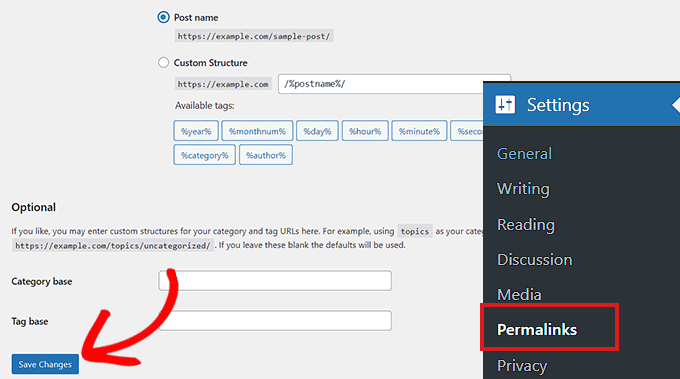
Es ist nicht notwendig, die Permalink-Einstellungen selbst zu ändern. Dadurch werden Ihre Permalink-Einstellungen aktualisiert und die Rewrite-Regeln geleert.
In den meisten Fällen behebt diese Lösung den 404-Fehler bei WordPress-Beiträgen. Wenn es bei Ihnen jedoch nicht funktioniert, müssen Sie wahrscheinlich Ihre .htaccess-Datei manuell aktualisieren.
Methode 3: Aktualisieren der WordPress-.htaccess-Datei
Bevor Sie beginnen, sollten Sie eine Sicherungskopie Ihrer WordPress.htaccess-Datei erstellen. Wenn etwas schief geht, können Sie die ursprüngliche Datei leicht wiederherstellen.
Nun müssen Sie eine Verbindung zu Ihrem Server herstellen, indem Sie einen FTP-Client wie FileZilla oder die Dateimanager-App in Ihrem WordPress-Hosting-Dashboard verwenden.
Als Nächstes müssen Sie die Datei .htaccess finden und bearbeiten, die sich am selben Ort wie die Ordner /wp-content/ und /wp-includes/ befindet.
Klicken Sie einfach mit der rechten Maustaste auf die Datei und wählen Sie „Dateiberechtigungen“.
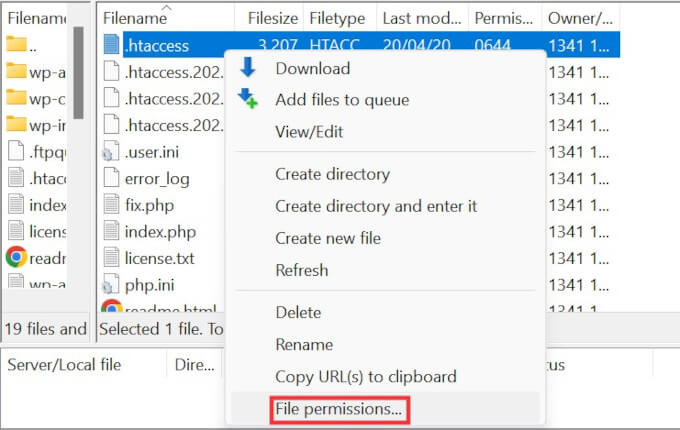
Sie können die Datei schreibbar machen, indem Sie ihre Berechtigungen auf 666 ändern.
Geben Sie einfach „666“ in das Feld „Numerischer Wert“ ein und klicken Sie dann auf „OK“.
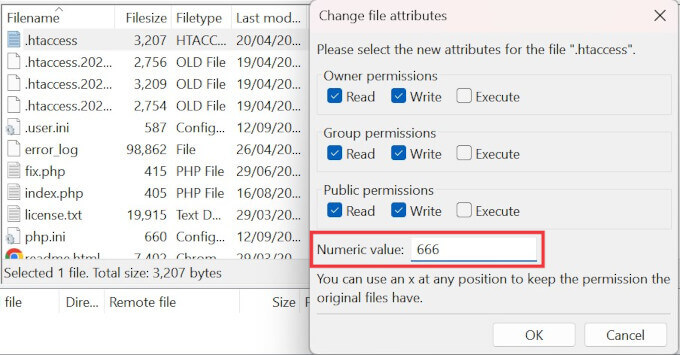
Dann müssen Sie die Schritte der ersten Methode unseres Tutorials wiederholen. Vergessen Sie danach nicht, die Berechtigungen wieder auf 660 zu ändern.
Sie können die Datei auch bearbeiten und ihr Code hinzufügen.
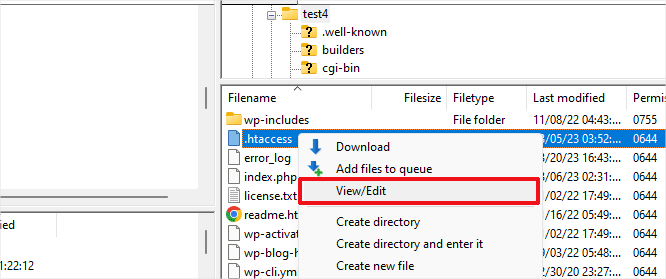
Nachdem Sie die .htaccess-Datei mit einem Texteditor geöffnet haben, fügen Sie einfach diesen Code ein:
# BEGIN WordPress
<IfModule mod_rewrite.c>
RewriteEngine On
RewriteBase /
RewriteRule ^index\.php$ - [L]
RewriteCond %{REQUEST_FILENAME} !-f
RewriteCond %{REQUEST_FILENAME} !-d
RewriteRule . /index.php [L]
</IfModule>
# END WordPress
Methode 4: Kontaktieren Sie Ihren Hosting-Anbieter
Wenn keine der oben genannten Lösungen das Problem der 404-Fehler bei WordPress-Beiträgen behoben hat, empfehlen wir Ihnen, sich an Ihren WordPress-Hosting-Anbieter zu wenden. Möglicherweise liegt ein Fehler auf dessen Seite vor, oder er kann Ihnen bei der Fehlerbehebung helfen.
Bitte lesen Sie auch unseren Leitfaden, wie Sie richtig nach WordPress-Support fragen und diesen auch erhalten.
Methode 5: Aktivieren Sie mod-rewrite (lokale WordPress-Installation)
Wenn Sie einen lokalen Server zu Testzwecken verwenden, müssen Sie mod_rewrite in der Apache-Konfiguration Ihrer MAMP-, WAMP- oder XAMPP-Site aktivieren.
Dies ermöglicht WordPress, saubere URLs zu generieren und den 404-Fehler für Beiträge und Seiten auf Ihrem lokalen Server zu vermeiden.
Wie Sie dies tun, hängt von der von Ihnen verwendeten Plattform ab. Benutzer von XAMPP können ihr Kontrollpanel öffnen und unter „Aktionen“ auf die Schaltfläche „Konfig“ klicken. Wählen Sie dann „Apache (httpd.conf)“.
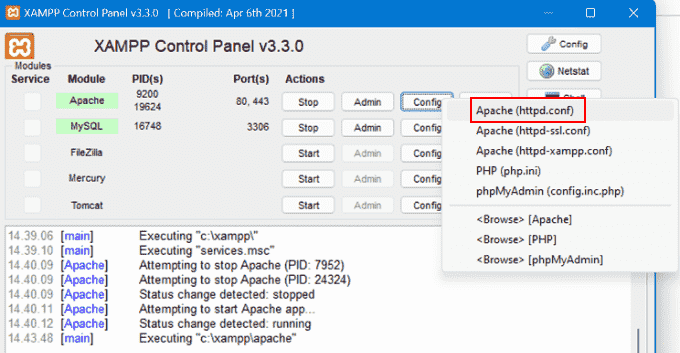
Als Nächstes müssen Sie diese Zeile #LoadModule rewrite_module modules/mod_rewrite.so finden und das ‚#‘ entfernen, um sie zu entkommentieren.
Dadurch wird mod_rewrite geladen.
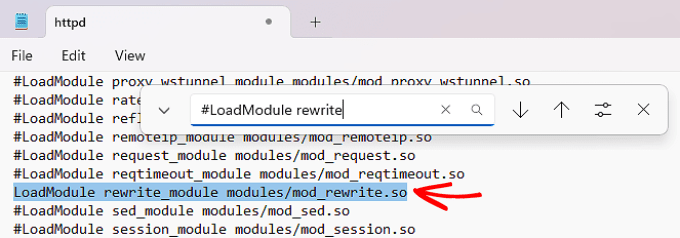
Suchen Sie dann alle Instanzen von AllowOverride None und ändern Sie sie in AllowOverride All.
Der Wert „Alle“ bedeutet, dass alle Direktiven überschrieben werden können.
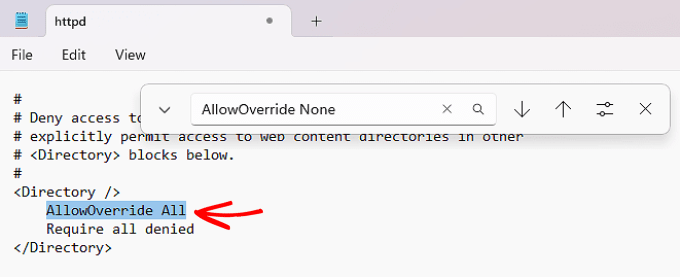
Danach können Sie die Datei httpd.conf speichern und schließen. Danach klicken Sie im XAMPP-Kontrollfeld auf „Stop“ für das Apache-Modul und erneut auf „Start“, um es neu zu starten.
Gehen Sie dann zurück zu Ihrem Admin-Dashboard, um zu sehen, ob Ihre Permalinks funktionieren.
Video-Anleitung
Wenn Sie eine visuelle Anleitung benötigen, sehen Sie sich einfach das folgende Video an.
Wir hoffen, dass dieser Artikel Ihnen geholfen hat, die 404-Fehler in WordPress zu beheben. Vielleicht interessieren Sie sich auch für unseren Leitfaden zu den häufigsten WordPress-Fehlern und deren Behebung sowie für unsere Expertenauswahl der besten WordPress-Plugins für das Wachstum Ihrer Website.
Wenn Ihnen dieser Artikel gefallen hat, dann abonnieren Sie bitte unseren YouTube-Kanal für WordPress-Videotutorials. Sie können uns auch auf Twitter und Facebook finden.





Laxmi Prasanna
thank you very much. you saved my day. god bless you
chandan
you save my day
Alessandro Morotti
Thxs a lot man.
Your save my job!!!
congratulations by your time
Niketa
Many many Thanks.. I was worried first but your blog fixed my 404…as I was having exactly same issue.
Abhishek Sharma
Sir i dont know how to thank you.. But today you saved my life.. I was so scared. I just published a post and then when i checked that in my browser it showed 404 error then i check another post and then all . i was surrounded by 404 errors except my homepage was working. Now before posting to wordpress forums i just googled it and found solution on your website.,..
Mannn Thanks for saving my life.
WPBeginner Support
Hi Abhishek,
We are glad you found this article helpful. Don’t forget to follow us on Facebook for more WordPress tips and tutorials.
Admin
Richard
Hi !
I doesn’t work for me.
i added “ . “ for prefix category but i fall in a 404 page when i try to access to my subcategory :s
CR
Awesome! It helped.
Paola
I LOVE YOU! I didn’t knew how to fix this I’m a complete novice. Thank you thank you! !
Marlena
I’m so pleased to have found this article first. I’m a complete novice and I fixed my own 404 issue.
YAY!
Thanks so much!
Saud Razzak
Very informative and useful article for WordPress beginners!
Eri
Please can you help me for this, because I tryied but i cant fix it :/
Tom C
Great guide! Totally solved my issue.
Anil
I have created a subdirectory. And I have two wordpress installed, one in root and the other in subdirectory. Both of them contains posts and pages. I want to access both and it’s happening. But when I am hiding the subdirectory slug from the post URL by modifying the .htaccess file, the sub directory name got hidden as per the requirement but the posts of my main domain is inaccessible and getting 404 error. I want to access the post from both root as well as subdirectory. Please suggest.
Jawad
Thank you very very much for your help
Farukh Hussain
Thanks alot for sharing. Your tutorials always helps me.
Karen
Thank you so much for this!
Grant Turner
Fixed. My problem was since I’m running on a windows server then I don’t have a .htaccess file. I need to create a web.config file.
Cindy Martin
This fix DID NOT work for me! I still have a 404 error on my blog page only. I am using Gridalicious and have had nothing but trouble! (Not with Gridalicious but other stuff too).
I removed everything from the to start over. loaded the theme and get the error.
Blog posts are not showing up on the blog page except in the widget and the main page is the 404 error message. Saving permalinks does nothing at all. Host is GoDaddy. HELP! I’m really tired of all this and frustrated.
WPBeginner Support
Hey Cindy,
This seems like an issue with your WordPress theme. Please follow the step by step instructions in our WordPress troubleshooting guide. It will help you figure out what’s causing the issue.
Admin
Maranna
Thanks! I moved website from one server to another and had the problem with posts returning 404. Main page and admin were working fine. Re-saving permalinks worked to fix this problem. Seems that this setting is not carried over correctly in all cases.
Aondongu Tivzenda
The permalinks fix worked perfectly. Thank you for this website. Awesome!
alvin
My problem is funny. I have a couple of WP websites I am currently running each logged into one browser with different portals and logging user names. After I noticed the 404 error checking the redirect area i see my author names have been mixed up from all the different websites. Can someone please assist
niranjan
It worked! Thanks!!
Vishwa
It worked! Thanks!!
Yours is a great website!
Charley Gordon
Thanks for sharing your knowledge.
Al
Thanks, worked for me
Mayapur Voice
This post saved my day today! In an attempt to fix a long standing problem today our host changed the .htaccess file. The issue got resolved but it broke all my links. By the grace of God, I found this post in an instant and it was exactly what I needed. Thanks tons!
marcela bonadio
exactly what i needed. thanks for sharing your knowledge.
Casey
Hello, thanks for this article and all the other awesome articles I have found on wpbeginner. I am running into some problems with my front page giving me an „oops! That page can’t be found“ error. I am wondering if you have any advice on how to fix it.
I am running:
LAMP with Debian 3.2.84-1 x86_64 (Wheezy) on a VPS, Apache 2.2.22, php5
Wordpress: 4.7.1
Theme: YS Magazine
The original issue occurred when I switched the permalink structure to use „post type“ instead of the default. At that point I could no longer view any of my pages and just got a 404 error. So, I did some research and edited my .htaccess file to allow overwrite. This fixed the problem of the 404 errors on all my pages, except on whatever page is set to my home page. To be clear, there was no problem with any of the pages before I changed permalinks. It also does not matter if I set the front page to static or posts. If I change my front page to another page I can then see the page which was set previously as the front page, but the new front page then gives me the error.
I have tried:
disabling all my plugins and enabling them one by one
changing themes
changing the .htaccess file back
changing permalink settings
I have been searching for an answer to this for hours now and seem to have ran into a brick wall. Any help would be super appreciated. Thank you so much.
Bart Dority
Thank you so much for this post!
I knew my 404 errors had something to do with the permalink structure – and I even tried changing the permalink structure and saving it – and otherwise updating and refreshing it — but it still wasn’t working. But then I read this post which said — instead of changing the permalink style and saving it, — just leave it where it is, and click Save anyway. That worked for me. A huge relief. Thank you!
Angelica
Thank you so much!! It worked!!
MarcB
Thank you so much for this help. Really a lifesaver.
Elyes Gherib
Thank you very much, this did it for me!
Z
Thanks for the post. I’ve had to deal with other problems after switching hosting providers, but this was a new one.
I did the method provided and my site was back to normal within seconds.
Kristine
Hello, I am hoping you can help me- I am super nervous about my wp site right now. When I type the address into the search engine it is a completely barebones site that says it is „set up through Wix“ that no longer looks like our site we have been operating through wordpress. This just happened out of the blue and I am so nervous about our posts.
WPBeginner Support
Hi Kristine,
It seems like your WordPress site’s domain is hosted by Wix. If you have login details for a wix account, then you can login and point the domain to your current WordPress hosting provider. If you are unsure, then please try contacting Wix support and your WordPress hosting provider support for more help.
Admin
Jolene
Thank you! My blog has been down and I couldn’t figure out how to fix. In a last ditch effort before I call customer support…I googled. You saved the day!
Bruno Almond
Great blog here! Additionally your site rather a lot up very fast! What host are you the usage of? Can I am getting your affiliate link in your host? I desire my web site loaded up as fast as yours lol
WPBeginner Support
Hi Bruno,
WPBeginner is hosted on a HostGator dedicated server.
Admin
AJ
great job mate, you did a better job than the tech support at bluehost
Lorene
No, this worked for the one post that was showing Error 404, but then ALL the others that worked before, now show Error 404. So I had to change it back. Hope most of them work now.
Gabe DeFrates
Excellent tip for fixing the permalink! I was getting the „File not found“ error, and I went right into the WP Control Panel Settings, Saved Changes and she’s working again. You saved the day! Thank you for your time in posting this.
Samnang Thorng
Thanks I can deal with site now. Great helps
jhonny
Recently I have changed my site permalinks and now i am getting lots of 404 errors i have redirected them some of them to new url and others to homepage but still my site users were going down and down what to do now help me please should i change them back to old permalinks? or something else to do please tell me
Exxagon
Thanks a lot for your post.
Since many weeks, I was stucked with a 404 error each time I tried to change my permalinks structure.
I found the solutions in your post :
1. Modify /etc/apache2/apache2.conf, and set „AllowOverride All“ everywhere instead of “ AllowOverride None“
2. Empty /var/www/html/.htaccess completely, change it to www-data:www-data & set it temporary to 777.
3. And the main one : „sudo a2enmod rewrite“, and „service apache2 restart“
Thanks again !!
Xavier
Asif
thanks bro it help me and my server version is working fine now
Suraj
Thanks a lot… It’s working for me.
Erwin
Hey, where can I find „/etc/apache2/apache2.conf“??? I don´t even know where to search? Do I need a special Application or something? Sorry, i´ve no idea : I
Abel
Hi, “/etc/apache2/apache2.conf” is a Ubuntu system folder. If you want to access it, you should have access to your server (like ssh).
Abel
Thanks a lot!
Vinita
Recently I am getting lots of 404 page errors in google webmaster. While revamping my wordpress website, instead of redirecting old urls to new, I just edited existing urls to new ones. e.g. website.com/url1 was edited to website.com/url2. Now webmaster if giving 404 error for old urls i.e. website.com/url1. How am I supposed to solve this error? (there are almost 155 urls with 404 errors so cant ignore)
WPBeginner Support
See our guide on how to setup redirects in WordPress.
Admin
Sandy
Is there a plugin that can find 404 errors and redirect them safely with best SEO tactics? Or should i do a edit find and replace in my xml file and remove the urls?
appreciate your ideas…
Michael
changing the right to 660 made my site unavailable. i had to set .htaccess to 644 (which was the original setting). regards Michael
Swadesh
Thanks a lot
Its working for me.
Kieron Atkinson
I’m running wordpress on a client’s in-house server and even though the htaccess file is there with the rewrite module sequence, permalinks are still not working. In fact all the URLs are coming up as example.com/index.php/permalink.
How do I check if the module rewrite is enabled on the server? My client says that they have that enabled but it still doesn’t work.
Many thanks for your help.
Kieron
Renee
Mahalo nui loa (thank you very much)!
Reassigning the Permalinks is exactly what was needed after moving 10 sites to a new hosting company.
Abundant blessings to you and your team.
WPBeginner Support
Hi Renee,
Glad you found it helpful and thanks for the kind words. You may also want to join us on Twitter for more WordPress tips and tutorials.
Admin
Steve
Thank you for your well written article. I have logged in to both /wp-content and /wp-includes/ and I havent found my .htaccess file.
Is it possible that I dont have one as I also get the 404 error if i try and redirect a page usin Redirection in WP.
Thanks in advance.
Steve
WPBeginner Support
Please see our guide on why you can’t find .htaccess file on your WordPress site.
Admin
Paras
hello
i am facing this same problem
i tried your method but still its showing error
Margarita
Today I was about to launch my web after 5 months working very hard in localhost. I was very happy but exhausted. While doing all the migration process, my site was gone. I had made a backup of course, but after trying a hundred times nothing worked. All seemed lost… until I found your post and it was solved in less than 30 min.
My day has been awful, a waste of many hours and energies. But now I go to bed with a smile in my face. Happy again. Infinite thanks.
Marga Rubio Soto
WPBeginner Support
You are welcome. We are glad you found the article helpful. Don’t forget to join us on Twitter for more WordPress tips and tutorials.
Admin